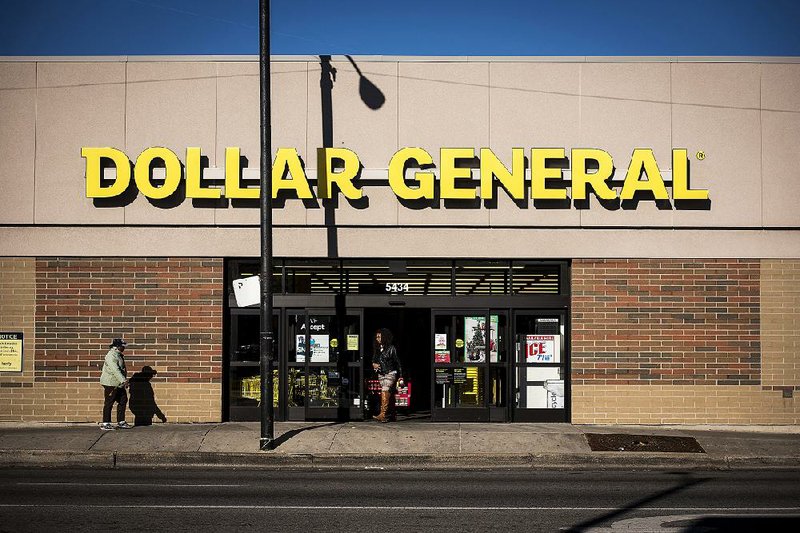As Walmart Inc. curtails the building of new stores in the U.S. to focus on bolstering its presence online and overseas, a much smaller player in the discount retail sector is seizing the opportunity to expand.
Dollar General's aggressive expansion of the past few years has included moving into some towns and even buildings vacated by Walmart. As it continues opening stores in fiscal 2019, the discount retail chain will further encroach on Walmart territory by selling fresh produce at more locations.
Dollar General, based in Goodlettsville, Tenn., plans to open 975 new stores in the fiscal year that starts Feb. 2. It opened about 900 stores in 2018. The company also plans to remodel 1,000 stores and relocate another 100, Chief Executive Officer Todd Vasos said in reporting third-quarter earnings last month.
The chain now operates more than 15,200 stores in 44 states, according to the company's website. Dollar General currently sells produce at 425 stores, and will add it to another 200 locations this year.
Walmart, which dominates the U.S. grocery market, had no comment regarding Dollar General. A spokesman for the Bentonville retailer said it doesn't address competitors' strategies.
Dollar General did not respond to submitted questions.
In January 2016, Walmart closed 154 U.S. stores in an effort to streamline operations. Most of the closures were smaller-format Walmart Express stores, including 11 in Arkansas. Dollar General subsequently bought more than 40 of the closed stores, three of which were in Arkansas.
Dollar General moved into a former Walmart Express in Decatur in 2017. At 12,000 square feet, the building is larger than the traditional Dollar General format of around 9,100 square feet. The extra space allows it to offer fresh meat and produce.
The other Walmart Express-turned-Dollar General stores in Arkansas were in Mulberry and Coal Hill. As in Decatur, Dollar General was able to move from a smaller store in Mulberry. The Coal Hill location was its first in that market.
Ken Perkins, founder of research firm Retail Metrics, said Dollar General typically locates stores in small towns and rural areas that are underserved by retailers. Some of these are considered "food deserts," lacking nearby grocery stores.
"The economics are increasingly difficult for mom-and-pop general stores to function in these communities, and Dollar General often moves in to fill the void," Perkins said.
For these reasons, Perkins doesn't see Dollar General as a threat to Walmart. However, Carol Spieckerman, a retail consultant and president of Spieckerman Retail, thinks otherwise, especially as the dollar chain rolls out more fresh-food offerings and increases the size and numbers of its stores.
"Dollar stores continue to up their grocery games, which increases the frequency of store visits and the opportunity to drive impulse purchases in higher-margin categories during those visits," Spieckerman said.
Walmart is countering these moves with its own small-format stores and multichannel capabilities, she said. Besides, "it does remain to be seen how many tens of thousands of stores dollar retailers can open before a saturation point is reached," Spieckerman said.
Dollar General reported third-quarter net sales up 8.7 percent over the same quarter the previous year. Same-store sales, or sales at stores open at least a year, grew 2.8 percent. Same-store sales are considered a key indicator of a retailer's health.
Spending at dollar stores overall rose in the past year, and consumers of all ages and income levels shop at dollar-store chains including Dollar General, Dollar Tree and Family Dollar, retail research and consulting firm The NPD Group said in a recent news release.
In the 12-month period ending in October, overall spending at dollar stores grew 7 percent, according to The NPD Group's analysis of sales receipts.
Shoppers with household incomes of $100,000 or more account for 32 percent of spending at dollar stores, according to the analysis. Spending was fairly evenly distributed among the other income groups, with those in the $25,000-to-$49,999 range comprising the second-largest group of dollar-store spenders, at 21 percent.
Thirty percent of dollar-store shoppers are between 45 and 54 years old. Those 55 and older represent a 23 percent share of spending, with the three categories of younger shoppers accounting for the rest.
In a strong economy, "it's counterintuitive that dollar stores would flourish," Perkins said. He sees several factors accounting for their continued growth.
One of these stems from the financial crisis of the last decade, Perkins said. The psychic scars it left "run so deep with so many Americans that they have held on to their value orientation and continued to shop for deals," he said. This is also why off-price retailers like TJX and Burlington are performing so well, he said.
While the U.S. economy is improving, Perkins said, it's not creating enough of the high-paying jobs "to allow consumers to move up the retail food chain." Add in the rising costs of health care and education, he said, and "there is little left over for an increasing number of families."
Perkins points out that these conditions are hitting the nation's rural areas particularly hard, and these are also the areas where Dollar General seeks to expand.
Finally, for more affluent customers, the local dollar store may be more of a convenience, he said, serving as a "fill in" stop between trips to the nearest grocery or big-box store.
SundayMonday Business on 01/06/2019
